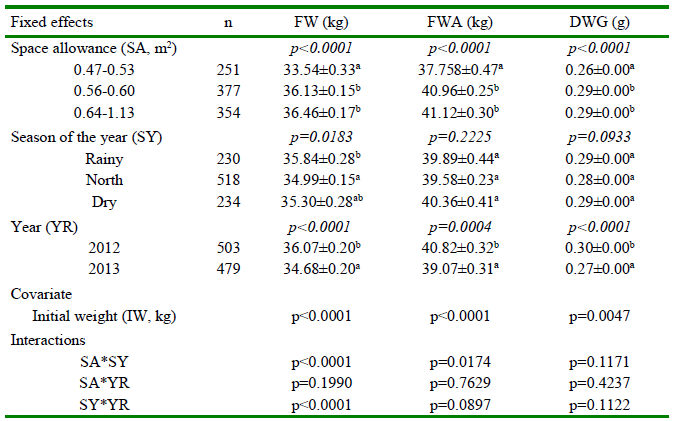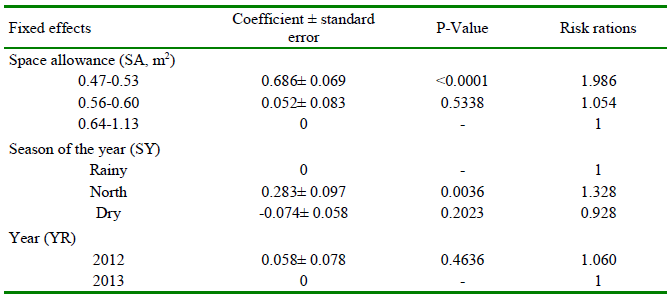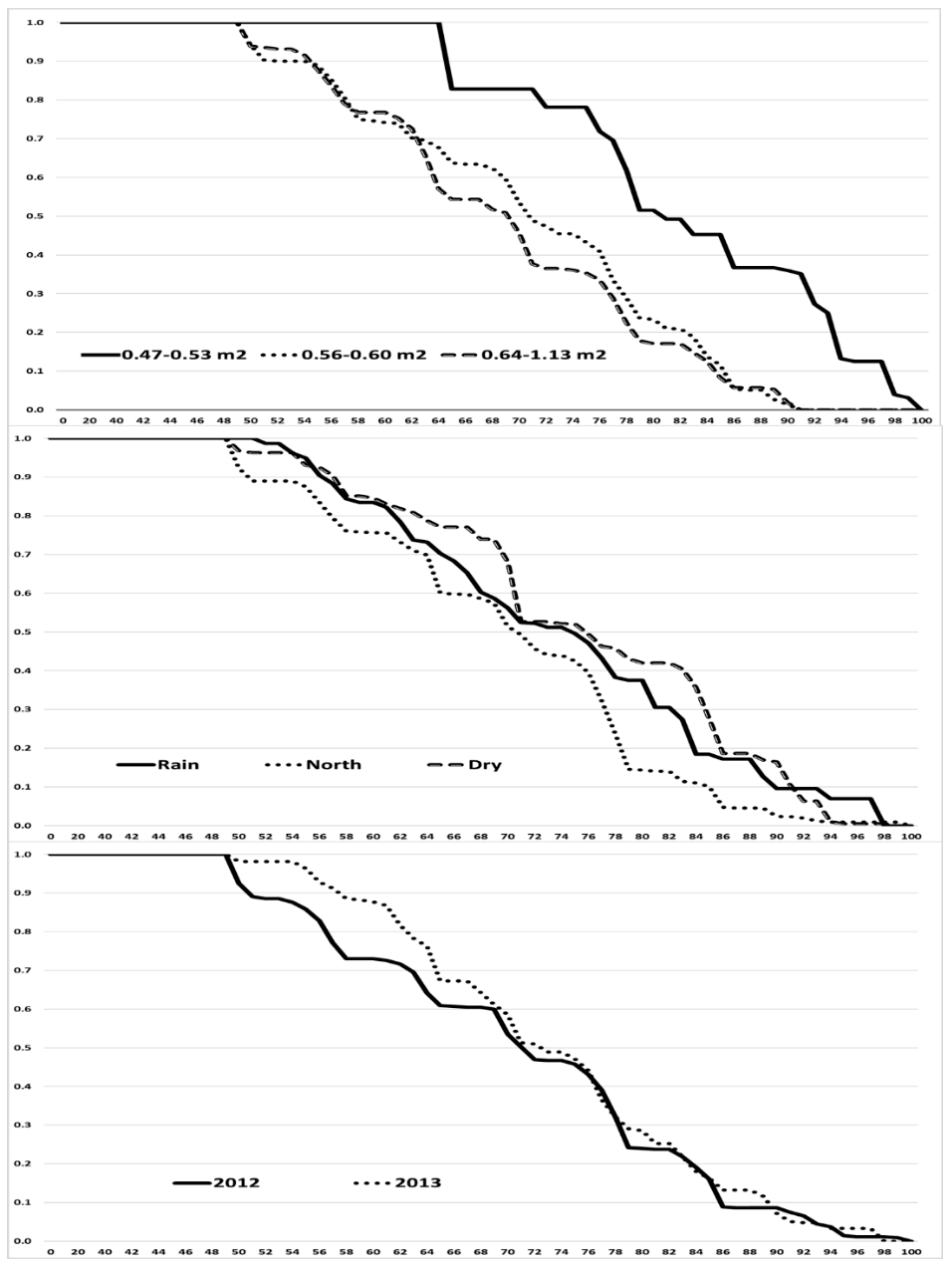INTRODUCTION
Currently in Mexico, different market niches are emerging with high and growing demand for finished lambs, carcasses, and/ or cuts from buyers in the centre of the country, regional processors, and consumers in urban and tourist areas, which are becoming increasingly important (Candelaria Martínez et al., 2015). To satisfy this demand for meat products, there are several ways, such as increasing the sheep inventory or increasing the final weight of the animals through selection, genetic improvement, and improvements in the production system; however, to satisfy the demand for meat quality by some consumers, it is necessary to finish lambs in intensive fattening systems (Mondragón-Ancelmo et al., 2014).
Under this context, in the tropical regions of Mexico, sheep meat is mainly produced in intensive fattening systems positioned at ground level or raised (Muñoz-Osorio et al., 2015). Comparative production advantages between one position and another can be determined by several factors, such as climate, feed availability, facilities, and management practices (Sánchez et al., 2019; Sánchez-Zarate et al., 2022).
Regarding facilities and management practices, Sánchez-Casanova et al. (2021) indicated the importance of the adequate use of space within the production systems of different farm animals. In fattening lambs, it has been reported that the larger the group size or stocking density in the pens, the more the productive parameters and comfort are negatively affected (Leme et al., 2013; Castillo-Trujillo et al., 2020). The reduction of space allowance or the increase in group size can affect the social environment, generating stress and modifying the affective states of the animals (Sánchez-Casanova et al., 2021). However, there is little research on the production of fattening lambs housed in raised slatted floor cages (RFC).
The space allowance recommended by the Mexican Sheep Product System for post-weaning lambs housed in the RFC is 1 m2/animal (Cuéllar, 2008). In this housing, however, Muñoz-Osorio et al. (2015) reported considerable variation in space allowance (0.6±0.3 m2) and group sizes (15.5±5.4 lambs) per pen. Besides, a recent study that determined the effect of the space allowance on growth of female hair lambs in the RFC concluded that space allowance should be adjusted between 0.69 and 0.60 m2/female lambs (Vázquez-Martínez et al., 2022). In male hair lambs, however, it is not known the space allowed per square meter for the finalization of lambs; space that cannot be the same as for growing females due to differences in body size.
Determining the space allowed according to animal size and sex is critical, due in part to the physical and mental degradation of the animals at the effects on productive traits, as well as the production costs that could result from changes in space for rearing animals (Ninomiya, 2014; Dawkins, 2017) which can also vary according to the year and the season of the year. In that sense, the objective of this study was to determine the effects of space allowance, season of the year, year and simple interactions on productive traits in hair lambs housed in RFC in the sub-humid tropics of Mexico.
MATERIALS AND METHODS
Study Site
A retrospective study was conducted on a commercial sheep farm located in the State of Yucatan, Mexico, and an altitude of 30 m above sea level. The climate is hot and humid with rainfall in summer (AW0). Average annual precipitation and temperature are 1183 mm and 26.4 °C, respectively (CONAGUA, 2013a,b). The average annual maximum and minimum relative humidity is 78 and 73%, respectively (INEGI, 2012).
Management
The animals in the study were crossbred lambs in unknown proportions of Pelibuey, Blackbelly, Dorper and Katahdin breeds. At weaning (approximately 60 days of age), lambs were identified with numbered ear tags and weighed with a digital hanging scale (ZENSUKYE 50 kg/reading accuracy 5 g). They were dewormed and vaccinated against pneumonia pasteurellosis. Lambs were housed in raised pens with slatted floor in different lamb group sizes (from 8 to 19 lambs per pen). The raised pen size was 9 m2. The height of the pen from ground level was 80 cm. The corrals were equipped with roofs, drinking troughs with fresh water available and linear feeders, approximately 250 cm long, located outside the corral, so that the raised pen space (9 m2) was only occupied by the animals. Feeding was based on the use of ad libitum commercial concentrate containing 12% humidity, 14.5% crude protein, 2.8% fat, 3.1% crude fibre, 62.60% nitrogen free extracts, and 5.0% ash (according to the manufacturer's data). In addition, lambs received Cynodon nlemfluensis, Brachiaria brizantha or Zea mays hay as a fibre source.
Data
Data of 982 lambs were recorded. The variables of study were initial fattening body weight (IW, kg), final body weight (FW, kg), start (DI) and end date (DF) of the lamb finalization period (FP) conducted during2012 and 2013. The FP was calculated as the difference between DF and DI, while daily weight gain (DWG, g) was calculated as the difference between FW and IW divided by FP. The FW was adjusted to 90 days of finalization (FWA, kg) using the following formula: FWA = DWG*90 d + IW (Hinojosa et al., 2013; Muñoz-Osorio et al., 2017). The FWA was estimated because it is the approximate period to reach the final commercial weight in lamb fattening farms in the sub-humid tropics of Mexico (Muñoz-Osorio et al., 2015). Feed intake data were not available; therefore, feed conversion was not estimated.
Lamb data were grouped in three lamb groups with spaces of allowance in raised pens of 0.47-0.53 m2, 0.56-0.60 m2 and 0.64-1.13 m2 per lamb, in three seasons of the year: dry from February to May, rainy from June to September and the north (Norte) from October to January and two years: 2012 and 2013 (Muñoz-Osorio et al., 2018).
Statistical Analysis
Initially, the normality assumptions were verified for the data of the study variables through the Kolmogorov-Smirnov test (Pr>D) using Proc UNIVARIATE of the SAS statistical package v. 9.0. The data corresponding to FW, FWAand FP presented a normal distribution (p>0.05), so to determine the effect of non-genetic or environmental factors on the study variables, a linear model was fitted. This model included the fixed effects of space allowance (SA: 0.47-0.53, 0.56-0.60,0.64-1.13 m2/animal), season of the year (SY: dry, rainy, north), year (YR: 2012, 2013), and simple interactions and IW as a covariate for dependent variables FW, FWA and DWG, using GLM procedure (SAS v. 9.0).
The linear expression of the final model was: Yijkl = µ + SAi + SYj + YRk + βIWl + (SAxSY) + (SAxYR) + (SYxYR) + εijkl, where Yijkl = FW, FWA, DWG; µ = overall mean; SAi = fixed effect of i-th the space allowance; SYj = fixed effect of k-th the season of the year; YRk = fixed effect of jth the year; βIWl = covariable of l-th the initial fattening body weight; (SAxSY) = interaction effect of space of allowance with season of year; (SAxYR) = interaction effect of space of allowance with year; (SYxYR) = interaction season of year with year; εijkl = residual random effects. A comparison of least square means between treatments were performed using least significant difference (LSD).
The data for the FP did not present a normal distribution (p<0.010) according to the Kolmogorov-Smirnov test (Pr>D), therefore, the data were analysed by event-time (days at fattening-final body weight, respectively), using the LIFETEST and PHREG procedures. The fixed model for FP included the effects of SA, SY, YR and IW as a covariate.
RESULTS AND DISCUSSION
Descriptive statistics
The means, standard deviation, minimum and maximum, and coefficients of variation (CV, %) for the study variables initial weight (IW, kg), final weight (FW, kg), and adjusted weight at 90 days of finalization (FWA, kg), daily weight gain (DWG, g) and finalization period (FP) are presented in Table 1. In overall, lambs had an IW of 14.29±3.52 kg and a FW of 35.75± 3.11 kg after 72.15±14.45 days of FP, a DWG of 0.29± 0.05 g and FWA of 40.50± 5.91.
Table 1. Descriptive statistics of the productive performance of hair lambs (n= 982) housed in raised slatted floor cage in the sub-humid tropics of Mexico

SD= Standard deviation; CV= Coefficients of variation
The productive data were within the range reported in a descriptive study of intensive lamb fattening systems in Yucatan, Mexico (Muñoz-Osorio et al., 2015): however, these values may differ with respect to other studies found in the literature (Villanueva-Partida et al., 2019; Vicente et al., 2020), due to other factors such as differences in climate, feeds, management, genetic lines, health status and type of housing (El Sabry et al., 2023).
Space Allowance (SA)
According to the results of the analysis of variance, the SA affected significantly (p<0.0001) FW, FWA and DWG (Table 2). The SA of 0.47-0.53 m2 presented the lowest FW (33.54±0.33 kg), FWA (37.75±0.47 kg) and DWG (0.26±0.00 g) in relation to the other two SA (p<0.05). Similarly, Vázquez-Martínez et al. (2022) reported lower production values in female lambs under SA of 0.56 m2/female lamb. On the other hand, Leme et al. (2013) reported a greater increase in body weight gains for lambs housed in double pens (two lambs/pen: 228 g/day) compared to lambs housed in collective pens (10 lambs/pen: 208 g/day), indicating that the number of individuals per group influences productive performance, changing the pattern of feed consumption that could improve weight gain.
Table 2. Least squares means and standard errors for space allowance, season of the year, year and their simple interactions to dependent variables final weight (FW, kg), adjusted weight at 90 days of finalization (FWA, kg) and daily weight gain (DWG, g) of hair lambs housed in raised slatted floor cage in the sub-humid tropics of Mexico

a,b Means with different superscripts indicate statistical differences (p<0.05)
Several studies have shown that feed competition, the design of the area available for feeding, moving and resting, the number of individuals present in the same housing and their social interactions, as well as the establishment of optimal environmental conditions play an important role in animal production and welfare (Estevez et al., 2007; Rice et al., 2016; Norouzian, 2017; Castillo-Trujillo et al., 2020; Sánchez-Casanova et al., 2021).
Season of the year (SY)
The SY affected FW (p=0.0183), being the rainy season the one that presented the greater weights (35.84±0.28 kg), but statistically similar to the dry season (35.30±0.28) (Table 2). In contrast, SY did not affect the variables FWA (p=0.2225) and DWG (p=0.0933). Similarly, Muñoz-Osorio et al. (2018) did not find found differences between rainy and dry seasons probably due to the ability of hair sheep to tolerate high temperatures (Rodríguez et al., 2016; Muñoz-Osorio et al., 2018). In this sense, Vicente et al. (2020) have indicated that it is possible for hair sheep to be efficient in the use of metabolizable energy and water, as well as in maintaining homeothermic conditions at a minimum energy cost in high temperature scenarios. In the northern season, however, it is possible that low temperatures, including the action of wind, humidity and precipitation among other factors, affected the postweaning growth of lambs housed in RFC with respect to the other seasons, probably because hair sheep (animals with less thickness and density of hair) need to expend more energy to maintain body temperature (Arias et al., 2008).
Year (YR)
The YR significantly affected (p<0.0001) all the study variables. Year 2012 presented the greatest FW (36.07±0.20 kg), FWA (40.82±0.32 kg) and DWG (0.30±0.00 g) (p<0.05; Table 2). The YR as fixed effect achieved a higher productive performance of lambs in 2012 compared to 2013 probably due to differences between the meteorological conditions presented during the study periods, as well as by other environmental and genetic factors (Muñoz-Osorio et al., 2017; 2018).
The WI as a covariate was significant in the model fit (p<0.0001) for FW, FWA and DWG (Table 2). This was the reason for its inclusion in the model as a covariate to adjust the differences in the WI of the animals that may be biased by differences in age and litter size at birth (Muñoz-Osorio et al., 2018). The interactions between SA*SY were significant for FW (p<0.0001) and FWA (p=0.0174), but not for DWG (p>0.05). The SY*YR interaction was also significant for FW (p<0.0001), but not for FWA and DWG (p>0.05). The remaining interactions were not significant for the study variables. The results obtained are presented in table 2.
The coefficients of the Cox model and the risk ratios (RR) for the finalization period (FP) are shown in Table 3. According to Wilcoxon and Chi-square tests, SA and SY showed a significant effect on FP, but not on YR.
Table 3. Cox model coefficients and risk of ratios for space allowance, season of the year and year to finalization period (FP, d) of hair lambs housed in raised slatted floor cage in the sub-humid tropics of Mexico

The risk ratio of 1.986 indicates that lambs in spaces of 0.47-0.53 m2 have a higher probability or risk of staying longer in fattening than lambs in spaces of 0.56-0.60 m2 or 0.64-1.13 m2 (RR=1.054 and RR=1, respectively) (Figure 1). In other words, lamb allowance in spaces >0.56 m2 had shorter FP due to higher DWG. This is explained because larger spaces are conducive to a full behavioural repertoire of animals, such as less time standing and more time eating, ruminating, walking, playing and resting (Norouzian, 2017; Sánchez-Casanova et al., 2021). Under this context, the SA is the one who determines the behaviour and productivity of the animals; therefore, it is necessary to increase the SA requirement as the size or number of animals housed in a space increases (El Sabry et al., 2023). Otherwise, the smaller space allowances increase aggressive behaviors and social stress in animals due to the invasion of individual space, affecting their growth rates and feed conversion (Estevez et al., 2007; Van et al., 2007; Ninomiya, 2014).

Figure 1. Probability for space allowance, season of the year and year to finalization period (FP, d) of hair lambs housed in raised slatted floor cage in the sub-humid tropics of Mexico
The risk of lambs having longer FP was higher during the north season (RR=1.328) as compared to the other two seasons (RR=0.928 and RR=1, respectively) (Figure 1). As indicated, lower temperatures in the north season could be having a negative influence on productive traits of lambs as they need to spend more energy to maintain body temperature. In contrast, the risk ratios for FP were similar for the years 2012 and 2013 as seen in Figure 1.
CONCLUSIONS
Space allowance, year, season of the year and simple interactions affected the productive traits of hair lambs housed in raised slatted floor cage in the sub-humid tropics of Mexico.
Larger space allowances resulted in better productive performance compared to smaller space allowance.
Under the conditions of the present study, space allowance for fattening lambs should be >0.56 m2 /animal.












 uBio
uBio 


